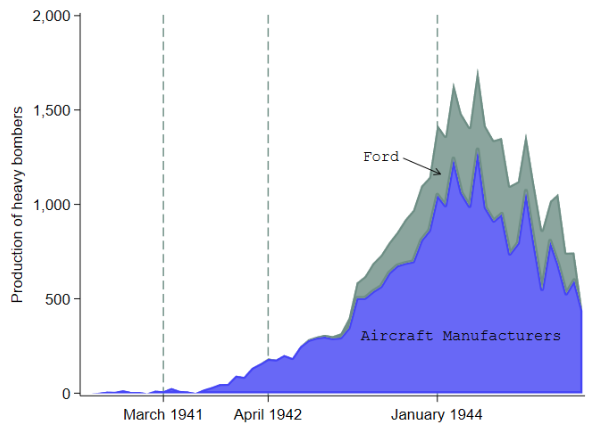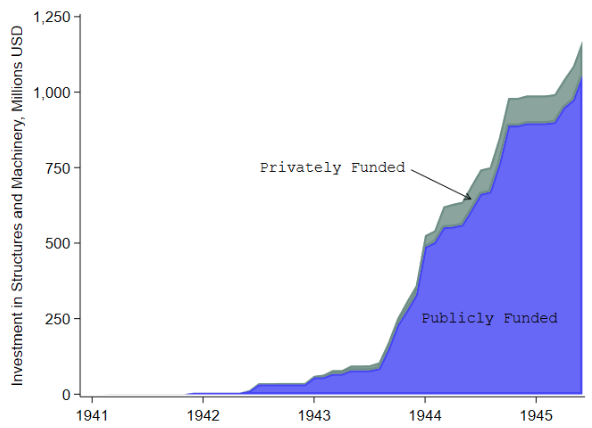The rapid spread of the COVID-19 virus revealed acute shortages of medical ventilators in countries around the world. The Economist estimated on 21 March that the US would run out of spare ventilators within four weeks. The situation may even be worse in other countries (such as the UK) and supplies are extremely limited in many developing countries. GlobalData estimates that global demand for ventilators this year will be 880,000, about nine times current global production capacity.
Governments have approached the challenge of ventilator shortages in different ways. Germany and Italy procured devices from existing leading manufacturers, while the US and UK have drawn wartime analogies and have called not only on existing ventilator producers, but also on firms from other industries to contribute to the warlike effort. The UK government has ordered ventilator production from a medley of firms, including Airbus and Dyson. The US invoked the Defence Production Act last week to help ventilator producers receive supplies and has called on auto manufacturers Ford and General Motors to produce ventilators. Calling on auto manufacturers to produce medical products – well outside their product range – echoes auto companies’ role in wartime production. With wartime analogies abound, it is worth reviewing the actual record of converting civilian to wartime production. We draw three lessons from US auto manufacturers’ experience in aircraft production during WWII.
1. Ramping up production takes time
With the pandemic peaking in parts of western Europe and close to peaking in the US and the UK, little time can be lost in replenishing ventilator supplies. There is no doubt that sophisticated automotive firms have the technological capacity to eventually produce a large number of medical devices. The question is whether they can they convert to medical equipment production in time to meet current needs. US auto manufacturers supplied a substantial share of motors, tanks, and jeeps during WWII. But these munitions were similar to their peacetime product lines. They also ventured into new products such as aircraft and a somewhat forgotten lesson from the war is how slow and difficult the conversion process was.
Perhaps the most notable example of such wartime conversion was the Ford B-24 bomber aircraft plant at Willow Run. Against the advice of the US Office of Production Management (OPM), which wanted the plant to produce only aircraft parts, Ford management insisted that they would produce entire planes (Herman 2012: 222). They broke ground on a factory in Ypsilanti, Michigan in March 1941 and promised to produce 500 bombers a month starting in April 1942. The government’s scepticism was based on the observation that conversion takes time. As William Kundsen, the head of the OPM put it to President Roosevelt: “Everyone knows that America is the greatest mass producer in the world. Not everyone knows that mass production takes time to get started” (quoted in Herman 2012: 146). Careful observation of existing experiences suggested that the conversion process took around 18 months in most industries (Herman 2012: 102, 146). Figure 1 vindicates this view in retrospect. The vertical lines show dates (from left to right) on which the Willow Run plant was founded, the plant had promised to begin delivering bomber aircrafts, and Ford first delivered the B-24s at the promised rate of 500 per month. Ford ultimately delivered on this promise, but the lag time was, if anything, greater than the US government feared.
Figure 1 Monthly production of heavy bombers in auto and aircraft manufacturers
Note: The figure shows total monthly production of heavy bomber aircrafts in Ford’s plant at Willow Run and in traditional aircraft manufacturers. Source: Sourcebook of World War II Basic Data and Ilzetzki (2020).
During this lag time, existing bomber producers put out more than 11,000 bomber aircrafts – more than Ford produced through the entire war. They did so by roughly doubling employment and almost tripling plant floor space in 1942 alone. This suggests that governments are better served by providing resources to existing producers than diverting them to other industries, especially when timely production is of high importance.
Analogies to the present should be drawn carefully. At the time, an aircraft consisted of nearly half a million parts and was far more complex a machine than an automobile. In contrast, medical ventilators comprise of less than 1,000 components and may be more amenable to imitation. In an era of 3D printers, global supply chains, and just-in-time production, conversion may be a more streamlined process. However, ventilator production is distinct from auto manufacturing, and currently limits on production aren’t due to the ventilator producers themselves, but their supply chains.
2. Sharing knowledge and supplies
What limits the supply of ventilators? Communication with top existing ventilator producers suggests they have the potential to increase production substantially. The main obstacle to mass ventilator production is the limited supply of production inputs: parts and components. The global hunt for production inputs risks devolving into a zero-sum game where ventilator producers compete for and bid up production input prices without increasing world ventilator supply. In this respect, auto manufacturers’ conversion to ventilator production may fail to increase the global availability of ventilators even if they are able to ramp up production themselves.
Similar competition over production inputs occurred during WWII and was recognised by the Truman Committee by the end of 1942. Aircraft manufacturers were fierce competitors before the war and cooperation didn’t come naturally to them. By 1942, the top nine US aircraft manufacturers were facing a backlog of $9 billion in orders (Klein 2013: 439). With shortages abound, manufacturers began competing over aircraft parts and poaching workers from one another. In response, Donald Douglas (founder of Douglas Aircraft) coordinated his peers under the umbrella of the Aircraft War Production council (AWPC). Aircraft manufacturers agreed to share everything including blueprints, techniques, and parts. For example, Vultee Aircraft shared engineering data worth $250,000 and 30 of its engineers with Consolidated Aircraft to aid the latter in B-17 production. Aircraft companies within the AWPC supplied each other with missing parts. Narrative histories from the period suggest that this cooperation helped maintain a steady output of aircrafts, particularly from plants in Southern California that were members of the AWPC.
The parallel to current circumstances is clear. National – and indeed international – supply chain coordination would help steer scarce production components to their best use. An international repository of knowledge should be created and supply chains should be mapped out and shared internationally. Here, too, the analogy is imperfect. Many existing ventilators are manufactured using specialized and custom-made parts, making it difficult to transfer components from one firm to another. However, policy should focus on easing the procurement of these parts rather than on the manufacture of final ventilators. A spokesperson for ResMed (a leading ventilator manufacturer) told us in private correspondence that “ResMed encourages all non-ventilator manufacturers wishing to help to please produce more of these needed components, rather than take from the limited supply to try making their own ventilators”.
3. Give them what they need
At the end of March, the US government was to sign an agreement with General Motors and their partner Ventec Life Systems for the production of 80,000 ventilators. The deal, however, was held back to assess the project’s costs. A particular point of discussion was GM’s requirement to be paid in advance for the retooling of their Kokomo plant to ventilator production. President Trump accused GM of wanting “top dollar”.
Here too, there are historical analogues. As the WWII production drive unfolded, corporations were reluctant to build new plants and production lines to meet a temporary increase in demand. This reluctance was itself borne out of previous historical experience. In WWI, private businesses met increased public demand for military equipment through privately financed expansions. This left businesses with large excess capacity and debt overhangs in the post-war period.
Having learned the lesson, in WWII, the Defence Plant Corporation (a government agency that was the successor of the New Deal Reconstruction Finance Corporation) provided $16 billion (17% of pre-war annual GDP) in direct investments in private productive capital – roughly two-thirds of wartime capital investment. The government retained ownership over the facilities and machinery it purchased, leased them to private corporations at a 4% annual rate (the government’s estimate of the depreciation rate) for the duration of the war, and gave operators the option to purchase the capital at its original cost at war-end.
Figure 2 shows cumulative capital investment in US aircraft plants during WWII. It shows that the aircraft production boom was almost entirely publicly financed and historical narrative suggests this was important to the success of the production drive. This is an important illustration that governments need to put financial resources where they claim their priorities lay, rather than try to win (literal or metaphorical) wars on the cheap.
Figure 2 Public and private investment, structures and machinery, aircraft producing plants
Source: Archives of the War Production Board and Ilzetzki (2020).
References
Baldwin, R (2020), “The Supply Side Matters: Guns Versus Butter, COVID-style”, VoxEU.org, 22 March.
Gourinchas, P-O (2020), “Flattening the Pandemic and Recession Curves,” in Baldwn, R. and B. Weder di Mauro, Mitigating the COVID Economic Crisis: Act Fast and Do Whatever It Takes VoxEU.org Ebook, London: CEPR Press.
Herman, A (2012), Freedom's Forge: How American Business Produced Victory in World War II. Random House.
Ilzetzki, E (2020). “Government Purchases and Plant-Level Productivity: Evidence from World War II,” mimeo.
Klein, M (2013), A Call To Arms: Mobilizing America for World War II. London: Bloomsbury Press.
Posen, A (2020) “Containing the Economic Nationalist Virus through Global Coordination,” in R Baldwin and B Weder di Mauro, Mitigating the COVID Economic Crisis: Act Fast and Do Whatever It Takes, a VoxEU.org eBook, CEPR Press.
Wei, S-J (2020) “Ten Keys to Beating Back COVID-19 and the Associated Economic Pandemic,” in Baldwn, R. and B. Weder di Mauro, Mitigating the COVID Economic Crisis: Act Fast and Do Whatever It Takes, a VoxEU.org eBook, CEPR Press.
White, G T (1949), “Financing Industrial Expansion for War: The Origin of the Defense Plant Corporation Leases,” Journal of Economic History 9(2): 156-18.
Endnotes
1 See https://www.globaldata.com/ventilator-crisis-during-coronavirus-outbreak-as-over-880000-are-needed/ and https://www.bloomberg.com/news/articles/2020-03-30/a-ventilator-maker-is-germany-s-best-performing-stock-this-year
2 See Gourinchas (2020) on the constraints that limited medical supplies put on the health system and Wei (2020) on the need to get ahead of the game on medical supply production.
3 https://edition.cnn.com/2020/04/02/politics/defense-production-act-ventilator-supplies/index.html
4 See Baldwin (2020) for other wartime lessons for the COVID-19 crisis.
5 Two additional auto manufacturers – General Motors and Nash – converted to aircraft production, with similar results.
6 In the words of Nick Oliver, automotive industry expert and Professor of Management at the University of Edinburgh: “There is no product that I can think of in the automotive industry that has to move air and oxygen around in a similar way to a ventilator.” Source: https://www.wired.co.uk/article/car-manufacturers-ventilators.
7 This is based on private correspondence with officials at Draegerwerk AG, ResMed, and Hamilton Medical: three leading ventilator manufacturers. They also cite the time required to train personnel to the specialized ventilator production process and shortage of testing equipment and specialized testing facilities. Hear also Planet Money episode 987 and see Financial Times (30 March 2020) in this regard.
8 See Posen (2020) on the need for an international response to the crisis, including on medical supplies.
9 https://www.nytimes.com/2020/03/26/us/politics/coronavirus-ventilators-trump.html
10 https://twitter.com/realdonaldtrump/status/1243557418556162050





